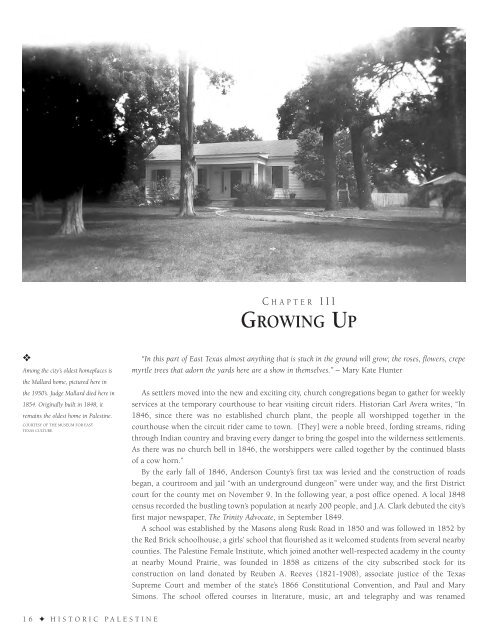Historic Palestine
An illustrated history of the Palestine, Texas area, paired with the histories of companies, families and organizations that make the region great.
An illustrated history of the Palestine, Texas area, paired with the histories of companies, families and organizations that make the region great.
Create successful ePaper yourself
Turn your PDF publications into a flip-book with our unique Google optimized e-Paper software.
C H A P T E R<br />
I I I<br />
GROWING UP<br />
❖<br />
Among the city’s oldest homeplaces is<br />
the Mallard home, pictured here in<br />
the 1950’s. Judge Mallard died here in<br />
1854. Originally built in 1848, it<br />
remains the oldest home in <strong>Palestine</strong>.<br />
COURTESY OF THE MUSEUM FOR EAST<br />
TEXAS CULTURE.<br />
“In this part of East Texas almost anything that is stuck in the ground will grow; the roses, flowers, crepe<br />
myrtle trees that adorn the yards here are a show in themselves.” – Mary Kate Hunter<br />
As settlers moved into the new and exciting city, church congregations began to gather for weekly<br />
services at the temporary courthouse to hear visiting circuit riders. Historian Carl Avera writes, “In<br />
1846, since there was no established church plant, the people all worshipped together in the<br />
courthouse when the circuit rider came to town. [They] were a noble breed, fording streams, riding<br />
through Indian country and braving every danger to bring the gospel into the wilderness settlements.<br />
As there was no church bell in 1846, the worshippers were called together by the continued blasts<br />
of a cow horn.”<br />
By the early fall of 1846, Anderson County’s first tax was levied and the construction of roads<br />
began, a courtroom and jail “with an underground dungeon” were under way, and the first District<br />
court for the county met on November 9. In the following year, a post office opened. A local 1848<br />
census recorded the bustling town’s population at nearly 200 people, and J.A. Clark debuted the city’s<br />
first major newspaper, The Trinity Advocate, in September 1849.<br />
A school was established by the Masons along Rusk Road in 1850 and was followed in 1852 by<br />
the Red Brick schoolhouse, a girls’ school that flourished as it welcomed students from several nearby<br />
counties. The <strong>Palestine</strong> Female Institute, which joined another well-respected academy in the county<br />
at nearby Mound Prairie, was founded in 1858 as citizens of the city subscribed stock for its<br />
construction on land donated by Reuben A. Reeves (1821-1908), associate justice of the Texas<br />
Supreme Court and member of the state’s 1866 Constitutional Convention, and Paul and Mary<br />
Simons. The school offered courses in literature, music, art and telegraphy and was renamed<br />
1 6 ✦ H I S T O R I C P A L E S T I N E
















